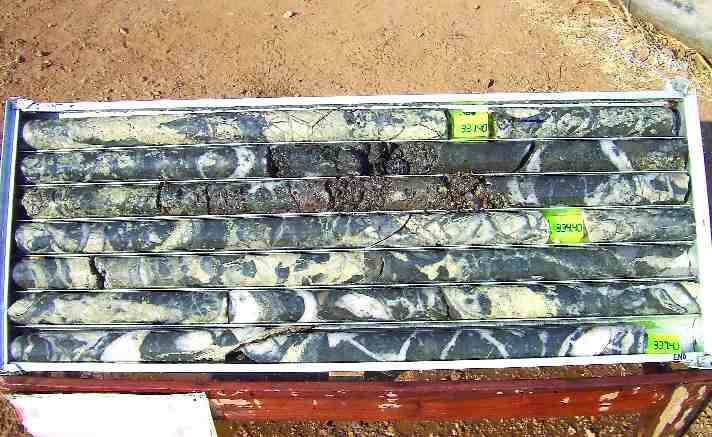Just a little more than two months after completing a 4,200-metre drilling program at its Dunrobin and Matala gold deposits in Zambia, Luiri Gold (LGL-V) released new mineral resource estimates showing an increase of 76% in total gold ounces.
Luiri Gold holds mineral tenements within southern-central Zambia covering about 2,400 sq. km. of exploration ground surrounding the historical Dunrobin and Matala gold mines. Known as the Luiri Hills project, the two sites, just 8 km apart, are located 120 km west-northwest of the Zambian capital of Lusaka, in the country’s Central province.
The positive news follows the successful May closing of a $4-million private placement to finance Luiri’s current growth program at Luiri Hills and evaluate potential gold acquisitions in Africa.
The new resource estimate at Luiri Hills shows the inferred resource increasing to 378,000 oz. gold from 173,000 oz. and the indicated resource increasing to 117,000 oz. gold from 108,000 oz. These ounces are contained in 3.2 million tonnes at 3.7 grams per tonne in the inferred category and 1.8 million tonnes at 2.0 grams per tonne in the indicated category.
The new results support Luiri Gold’s decision in June to undertake an aggressive 10,000-metre drilling program. The company says it will drill 8,000 metres at the Matala and Dunrobin deposits. The drilling should be completed by the end of the year, after which a preliminary economic assessment will be undertaken. The remaining 2,000 metres of drilling will focus on regional targets in the Matala dome.
“The original thing that attracted me to the project and still does is that the mineralization hangs together at higher-grade cutoffs,” says Luiri Gold’s president and CEO Mike Sperinck. “Often with gold projects grade is king. That is, you can deal with many problems, be it infrastructure, power or metallurgy, if you have the grade.”
At Matala, while there is potential for parts of it to be mined from an open pit, the thinner high-grade option should always be feasible with narrow mining methods that are widespread in Africa.
Sperinck notes that Matala and Dunrobin represent two different styles of mineralization that the company is expecting to find elsewhere in the Matala dome, namely steeply dipping, thinner but high-grade mineralization. That will potentially lend itself to underground mining as well as wider lower-grade mineralization that may lend itself to open pit mining methods, which in itself contains higher grades.
Since acquiring the Luiri Hills project at the end of 2003, Luiri Gold has been busy on several fronts: exploration drilling of the old Dunrobin and Matala mine sites; developing an exploration model to apply in regional exploration programs; field mapping around Dunrobin and Matala; historical data collection; remote sensing interpretation; small geochemical soil sampling programs at Dunrobin and Matala; and the excavation or re-excavation of shallow trenches across the Matala deposit.
The Matala resource model incorporates the Matala deposit within a tabular, south-dipping zone extending over 1,000 metres of strike. The average dip of the mineralization zone is estimated to be 65 to the south, although locally the dip ranges between 45 and 80.
The true width of the main mineralization zone evaluated ranges from less than 1 metre to 20 metres, with an average of just over 5 metres. In addition to the main zone, the deposit includes a number of minor footwall and hanging wall zones of mineralization, which have not been modelled and are not included in the latest resource estimate.
The Dunrobin resource estimate includes the Dunrobin deposit, a shallow, thick, tabular plunging orebody dipping at approximately 30 to the southwest on the contact between the Matala dome and the surrounding Lusaka formation.
The Luiri Hills project area is adjacent to ground held by BHP Billiton (BHP-N) in a joint venture with other parties. The JV has been exploring for iron oxide gold-copper (IOCG) minerals. And independent research has shown similarities between the Dunrobin gold deposit and the Kansanshi copper-gold mine of First Quantum Minerals (FM-T, FQM-L), 350 km north of Luiri Hills.
While gold is Luiri Gold’s focus, there is clearly significant potential for major copper deposits in the area, and the company’s exploration programs will be assessed for base metal potential.
Central-southern Zambia has not been as widely explored as the Copper Belt in the north, which has the largest copper-cobalt deposits for which the country and the Democratic Republic of the Congo are so well known. But Luiri argues exploration companies are showing more interest in Zambia, due to the country’s continued political stability and the upswing in the resource sector.
Interest is now not only focused on the Copper Belt in the north, but throughout most of southern Zambia, with targeted metals including copper, gold, zinc, nickel and even uranium. Many of the areas have the potential for more than one metal type.
Sperinck believes Zambia will end up with a mining code similar to Tanzania’s and is bullish on the country’s mining prospects. Zambia has “one of the better risk profiles in Africa,” says Sperinck, who was formerly part of the Randgold Resources (GOLD-Q) team that took the Morila gold mine in Mali from discovery to an over 5-million-oz. gold mine in four years.
“Many of the more common gold producing countries on the continent have been explored by many companies and while I believe there are still deposits to find there, it is going to get harder,” he says. “However, the area where we are exploring for gold in Zambia has had very little advanced exploration for gold and copper-gold. The point is, with limited work, we have been able to define half a million ounces for less than five dollars per ounce.”


Be the first to comment on "Luiri Gold shows lustre in Zambia (August 27, 2007)"